Cloud Computing Technology and Application: Major Vendor Analysis
VerifiedAdded on 2022/11/19
|19
|5142
|92
Report
AI Summary
This report provides a comprehensive overview of cloud computing technology and its various applications. It begins with an introduction outlining the aims and objectives of the research, which include assessing the applications of cloud computing, identifying its different applications, comparing major cloud vendors, and providing recommendations for effective cloud use. The literature review explores the concept of cloud computing, including Infrastructure as a Service (IaaS), Platform as a Service (PaaS), and Software as a Service (SaaS), along with their advantages and disadvantages. The report then compares major cloud vendors such as Microsoft Azure, Google Cloud Platform, IBM Cloud, Amazon Web Services, and VMware, evaluating their services and features. The report concludes with recommendations for the effective use of cloud computing, based on the analysis of the different vendors and their offerings. The report emphasizes the benefits of cloud computing, such as on-demand services, efficient data storage, and scalability, while also addressing potential disadvantages like security risks and implementation costs.
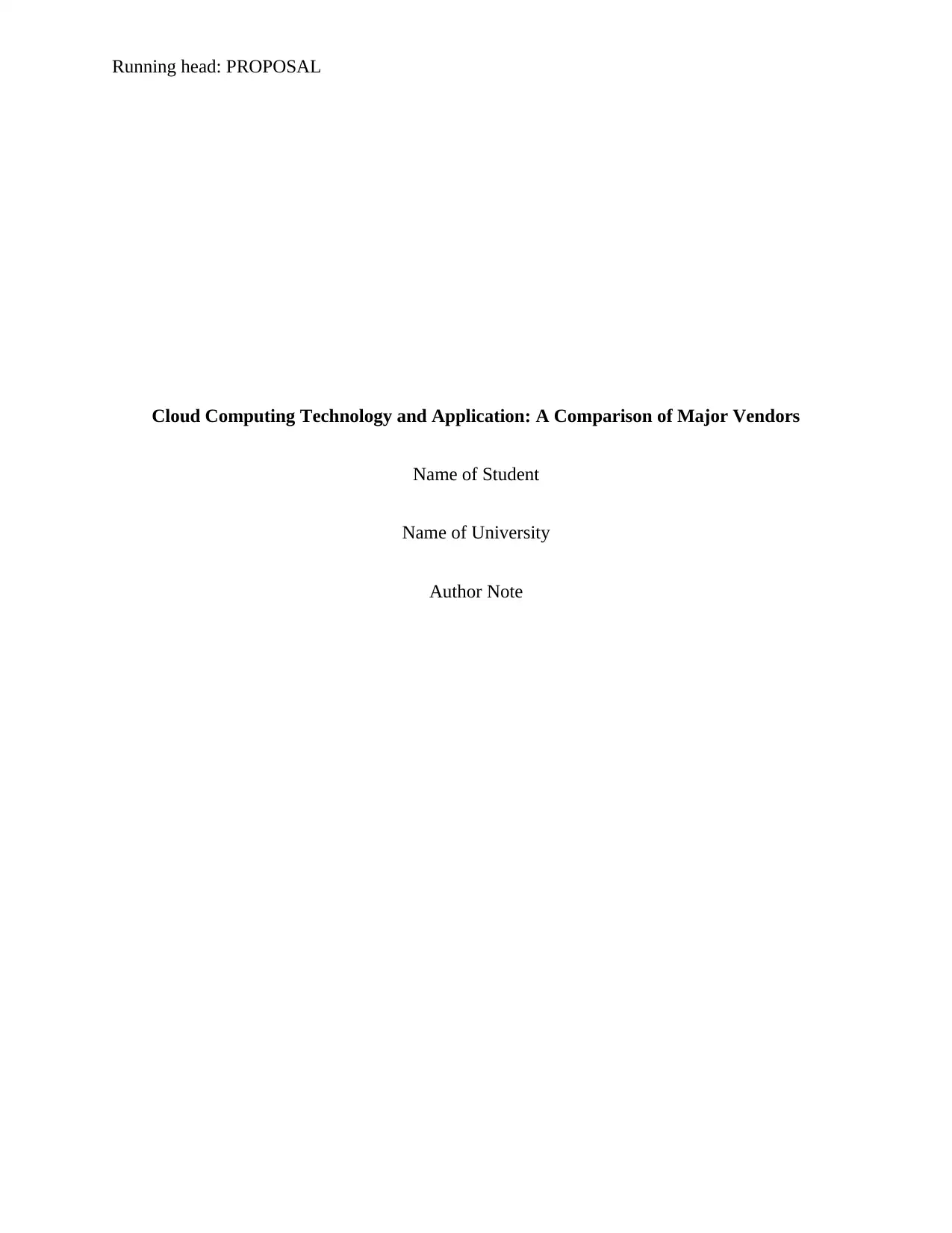
Running head: PROPOSAL
Cloud Computing Technology and Application: A Comparison of Major Vendors
Name of Student
Name of University
Author Note
Cloud Computing Technology and Application: A Comparison of Major Vendors
Name of Student
Name of University
Author Note
Paraphrase This Document
Need a fresh take? Get an instant paraphrase of this document with our AI Paraphraser
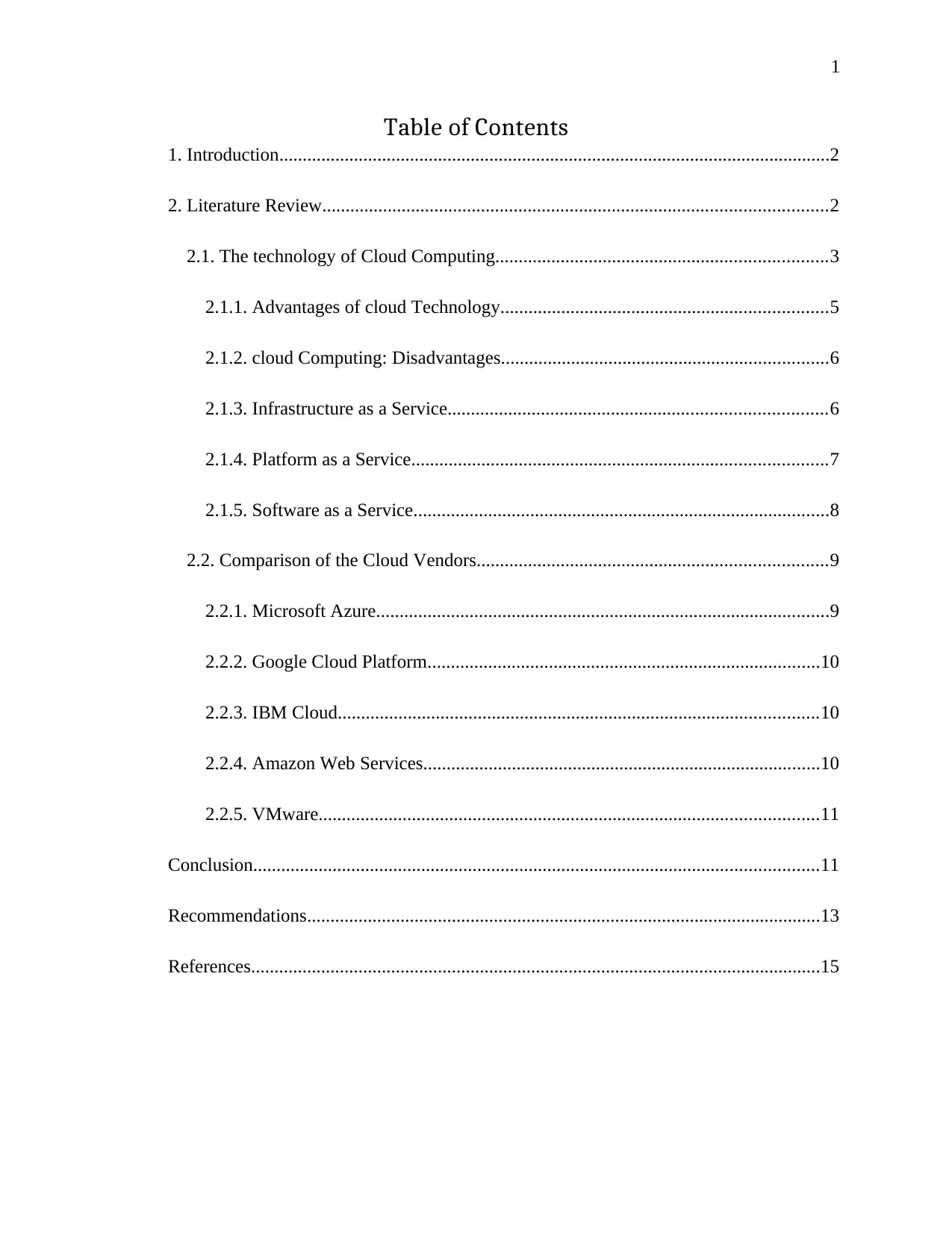
1
Table of Contents
1. Introduction......................................................................................................................2
2. Literature Review............................................................................................................2
2.1. The technology of Cloud Computing.......................................................................3
2.1.1. Advantages of cloud Technology......................................................................5
2.1.2. cloud Computing: Disadvantages......................................................................6
2.1.3. Infrastructure as a Service.................................................................................6
2.1.4. Platform as a Service.........................................................................................7
2.1.5. Software as a Service.........................................................................................8
2.2. Comparison of the Cloud Vendors...........................................................................9
2.2.1. Microsoft Azure.................................................................................................9
2.2.2. Google Cloud Platform....................................................................................10
2.2.3. IBM Cloud.......................................................................................................10
2.2.4. Amazon Web Services.....................................................................................10
2.2.5. VMware...........................................................................................................11
Conclusion.........................................................................................................................11
Recommendations..............................................................................................................13
References..........................................................................................................................15
Table of Contents
1. Introduction......................................................................................................................2
2. Literature Review............................................................................................................2
2.1. The technology of Cloud Computing.......................................................................3
2.1.1. Advantages of cloud Technology......................................................................5
2.1.2. cloud Computing: Disadvantages......................................................................6
2.1.3. Infrastructure as a Service.................................................................................6
2.1.4. Platform as a Service.........................................................................................7
2.1.5. Software as a Service.........................................................................................8
2.2. Comparison of the Cloud Vendors...........................................................................9
2.2.1. Microsoft Azure.................................................................................................9
2.2.2. Google Cloud Platform....................................................................................10
2.2.3. IBM Cloud.......................................................................................................10
2.2.4. Amazon Web Services.....................................................................................10
2.2.5. VMware...........................................................................................................11
Conclusion.........................................................................................................................11
Recommendations..............................................................................................................13
References..........................................................................................................................15
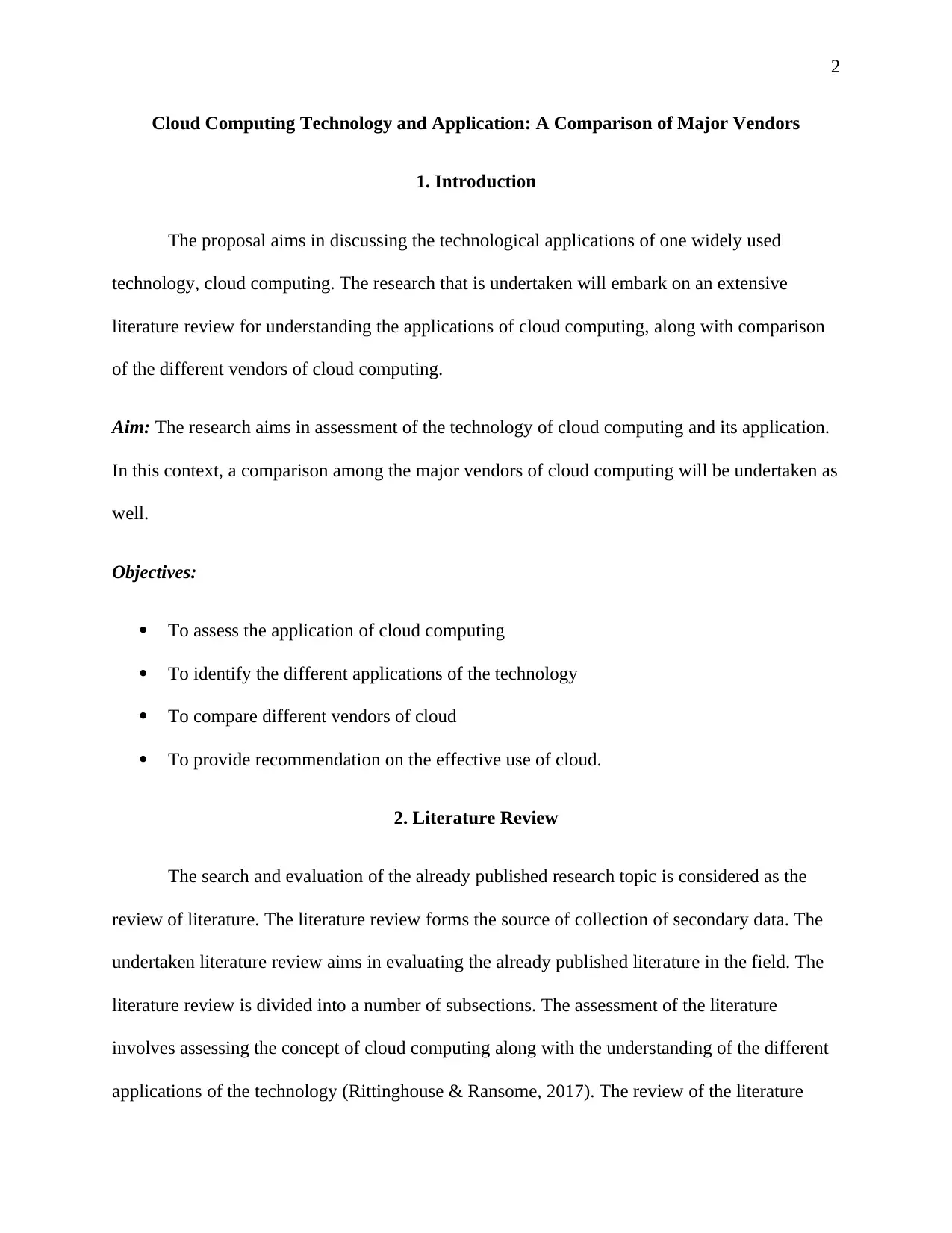
2
Cloud Computing Technology and Application: A Comparison of Major Vendors
1. Introduction
The proposal aims in discussing the technological applications of one widely used
technology, cloud computing. The research that is undertaken will embark on an extensive
literature review for understanding the applications of cloud computing, along with comparison
of the different vendors of cloud computing.
Aim: The research aims in assessment of the technology of cloud computing and its application.
In this context, a comparison among the major vendors of cloud computing will be undertaken as
well.
Objectives:
To assess the application of cloud computing
To identify the different applications of the technology
To compare different vendors of cloud
To provide recommendation on the effective use of cloud.
2. Literature Review
The search and evaluation of the already published research topic is considered as the
review of literature. The literature review forms the source of collection of secondary data. The
undertaken literature review aims in evaluating the already published literature in the field. The
literature review is divided into a number of subsections. The assessment of the literature
involves assessing the concept of cloud computing along with the understanding of the different
applications of the technology (Rittinghouse & Ransome, 2017). The review of the literature
Cloud Computing Technology and Application: A Comparison of Major Vendors
1. Introduction
The proposal aims in discussing the technological applications of one widely used
technology, cloud computing. The research that is undertaken will embark on an extensive
literature review for understanding the applications of cloud computing, along with comparison
of the different vendors of cloud computing.
Aim: The research aims in assessment of the technology of cloud computing and its application.
In this context, a comparison among the major vendors of cloud computing will be undertaken as
well.
Objectives:
To assess the application of cloud computing
To identify the different applications of the technology
To compare different vendors of cloud
To provide recommendation on the effective use of cloud.
2. Literature Review
The search and evaluation of the already published research topic is considered as the
review of literature. The literature review forms the source of collection of secondary data. The
undertaken literature review aims in evaluating the already published literature in the field. The
literature review is divided into a number of subsections. The assessment of the literature
involves assessing the concept of cloud computing along with the understanding of the different
applications of the technology (Rittinghouse & Ransome, 2017). The review of the literature
⊘ This is a preview!⊘
Do you want full access?
Subscribe today to unlock all pages.

Trusted by 1+ million students worldwide
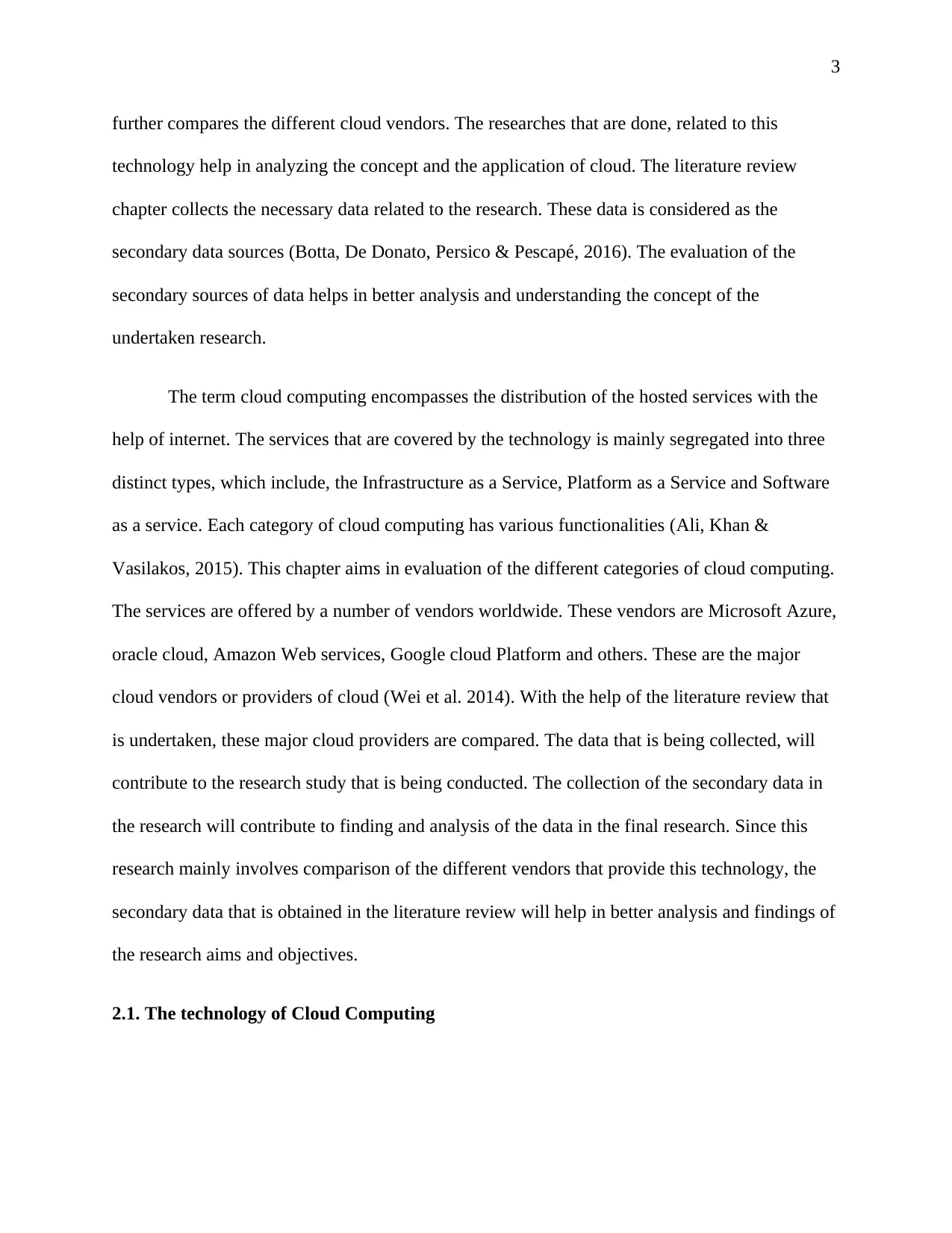
3
further compares the different cloud vendors. The researches that are done, related to this
technology help in analyzing the concept and the application of cloud. The literature review
chapter collects the necessary data related to the research. These data is considered as the
secondary data sources (Botta, De Donato, Persico & Pescapé, 2016). The evaluation of the
secondary sources of data helps in better analysis and understanding the concept of the
undertaken research.
The term cloud computing encompasses the distribution of the hosted services with the
help of internet. The services that are covered by the technology is mainly segregated into three
distinct types, which include, the Infrastructure as a Service, Platform as a Service and Software
as a service. Each category of cloud computing has various functionalities (Ali, Khan &
Vasilakos, 2015). This chapter aims in evaluation of the different categories of cloud computing.
The services are offered by a number of vendors worldwide. These vendors are Microsoft Azure,
oracle cloud, Amazon Web services, Google cloud Platform and others. These are the major
cloud vendors or providers of cloud (Wei et al. 2014). With the help of the literature review that
is undertaken, these major cloud providers are compared. The data that is being collected, will
contribute to the research study that is being conducted. The collection of the secondary data in
the research will contribute to finding and analysis of the data in the final research. Since this
research mainly involves comparison of the different vendors that provide this technology, the
secondary data that is obtained in the literature review will help in better analysis and findings of
the research aims and objectives.
2.1. The technology of Cloud Computing
further compares the different cloud vendors. The researches that are done, related to this
technology help in analyzing the concept and the application of cloud. The literature review
chapter collects the necessary data related to the research. These data is considered as the
secondary data sources (Botta, De Donato, Persico & Pescapé, 2016). The evaluation of the
secondary sources of data helps in better analysis and understanding the concept of the
undertaken research.
The term cloud computing encompasses the distribution of the hosted services with the
help of internet. The services that are covered by the technology is mainly segregated into three
distinct types, which include, the Infrastructure as a Service, Platform as a Service and Software
as a service. Each category of cloud computing has various functionalities (Ali, Khan &
Vasilakos, 2015). This chapter aims in evaluation of the different categories of cloud computing.
The services are offered by a number of vendors worldwide. These vendors are Microsoft Azure,
oracle cloud, Amazon Web services, Google cloud Platform and others. These are the major
cloud vendors or providers of cloud (Wei et al. 2014). With the help of the literature review that
is undertaken, these major cloud providers are compared. The data that is being collected, will
contribute to the research study that is being conducted. The collection of the secondary data in
the research will contribute to finding and analysis of the data in the final research. Since this
research mainly involves comparison of the different vendors that provide this technology, the
secondary data that is obtained in the literature review will help in better analysis and findings of
the research aims and objectives.
2.1. The technology of Cloud Computing
Paraphrase This Document
Need a fresh take? Get an instant paraphrase of this document with our AI Paraphraser
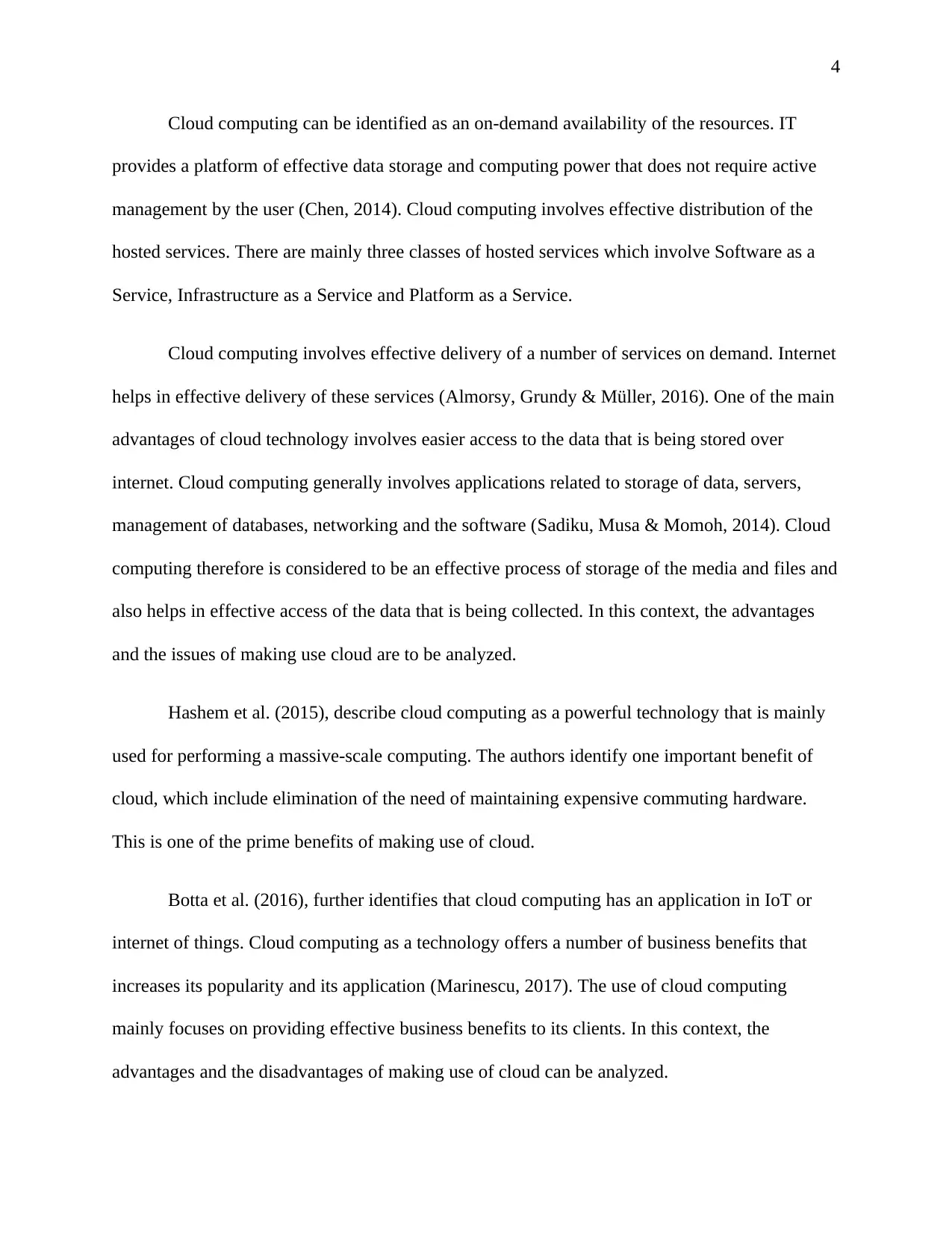
4
Cloud computing can be identified as an on-demand availability of the resources. IT
provides a platform of effective data storage and computing power that does not require active
management by the user (Chen, 2014). Cloud computing involves effective distribution of the
hosted services. There are mainly three classes of hosted services which involve Software as a
Service, Infrastructure as a Service and Platform as a Service.
Cloud computing involves effective delivery of a number of services on demand. Internet
helps in effective delivery of these services (Almorsy, Grundy & Müller, 2016). One of the main
advantages of cloud technology involves easier access to the data that is being stored over
internet. Cloud computing generally involves applications related to storage of data, servers,
management of databases, networking and the software (Sadiku, Musa & Momoh, 2014). Cloud
computing therefore is considered to be an effective process of storage of the media and files and
also helps in effective access of the data that is being collected. In this context, the advantages
and the issues of making use cloud are to be analyzed.
Hashem et al. (2015), describe cloud computing as a powerful technology that is mainly
used for performing a massive-scale computing. The authors identify one important benefit of
cloud, which include elimination of the need of maintaining expensive commuting hardware.
This is one of the prime benefits of making use of cloud.
Botta et al. (2016), further identifies that cloud computing has an application in IoT or
internet of things. Cloud computing as a technology offers a number of business benefits that
increases its popularity and its application (Marinescu, 2017). The use of cloud computing
mainly focuses on providing effective business benefits to its clients. In this context, the
advantages and the disadvantages of making use of cloud can be analyzed.
Cloud computing can be identified as an on-demand availability of the resources. IT
provides a platform of effective data storage and computing power that does not require active
management by the user (Chen, 2014). Cloud computing involves effective distribution of the
hosted services. There are mainly three classes of hosted services which involve Software as a
Service, Infrastructure as a Service and Platform as a Service.
Cloud computing involves effective delivery of a number of services on demand. Internet
helps in effective delivery of these services (Almorsy, Grundy & Müller, 2016). One of the main
advantages of cloud technology involves easier access to the data that is being stored over
internet. Cloud computing generally involves applications related to storage of data, servers,
management of databases, networking and the software (Sadiku, Musa & Momoh, 2014). Cloud
computing therefore is considered to be an effective process of storage of the media and files and
also helps in effective access of the data that is being collected. In this context, the advantages
and the issues of making use cloud are to be analyzed.
Hashem et al. (2015), describe cloud computing as a powerful technology that is mainly
used for performing a massive-scale computing. The authors identify one important benefit of
cloud, which include elimination of the need of maintaining expensive commuting hardware.
This is one of the prime benefits of making use of cloud.
Botta et al. (2016), further identifies that cloud computing has an application in IoT or
internet of things. Cloud computing as a technology offers a number of business benefits that
increases its popularity and its application (Marinescu, 2017). The use of cloud computing
mainly focuses on providing effective business benefits to its clients. In this context, the
advantages and the disadvantages of making use of cloud can be analyzed.
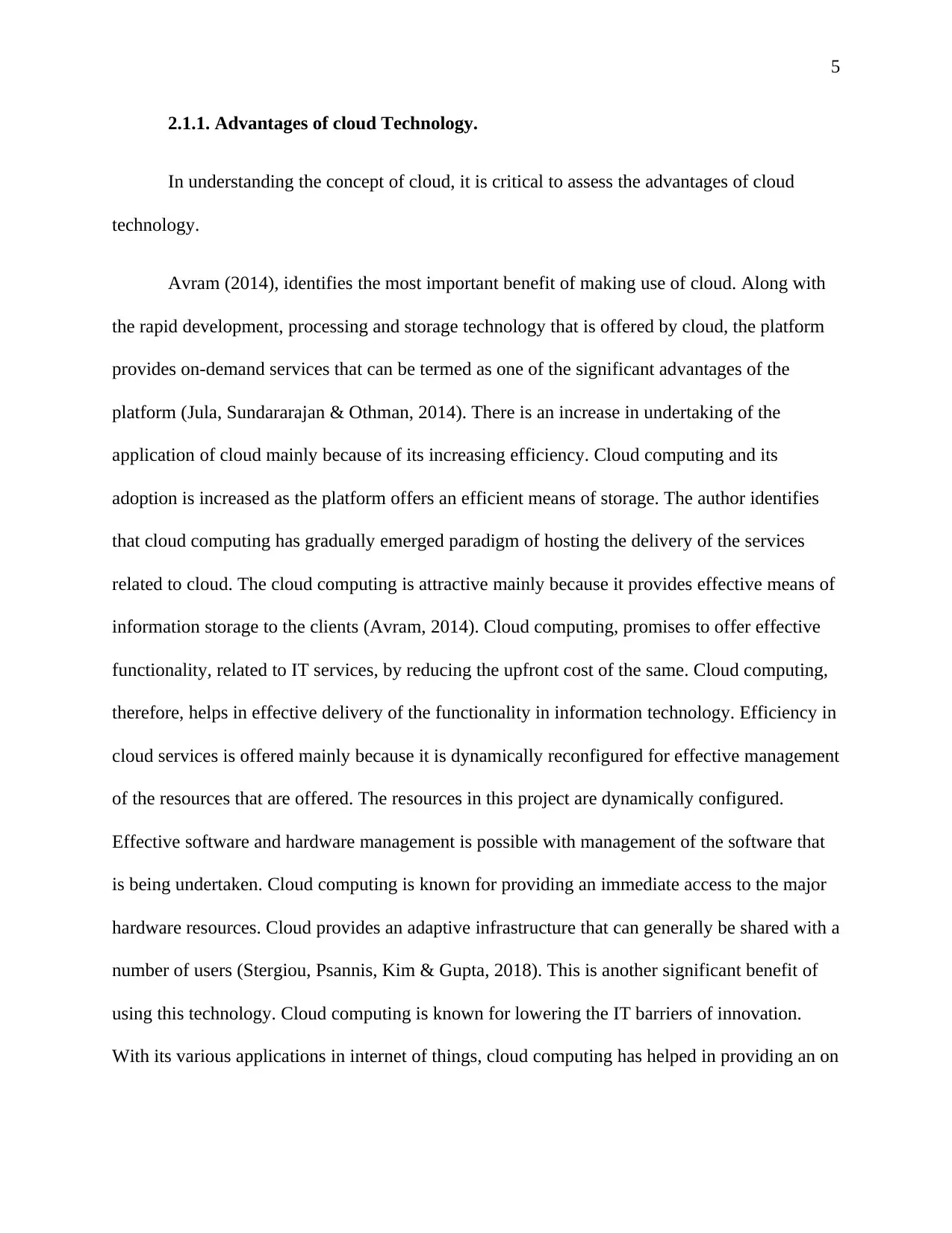
5
2.1.1. Advantages of cloud Technology.
In understanding the concept of cloud, it is critical to assess the advantages of cloud
technology.
Avram (2014), identifies the most important benefit of making use of cloud. Along with
the rapid development, processing and storage technology that is offered by cloud, the platform
provides on-demand services that can be termed as one of the significant advantages of the
platform (Jula, Sundararajan & Othman, 2014). There is an increase in undertaking of the
application of cloud mainly because of its increasing efficiency. Cloud computing and its
adoption is increased as the platform offers an efficient means of storage. The author identifies
that cloud computing has gradually emerged paradigm of hosting the delivery of the services
related to cloud. The cloud computing is attractive mainly because it provides effective means of
information storage to the clients (Avram, 2014). Cloud computing, promises to offer effective
functionality, related to IT services, by reducing the upfront cost of the same. Cloud computing,
therefore, helps in effective delivery of the functionality in information technology. Efficiency in
cloud services is offered mainly because it is dynamically reconfigured for effective management
of the resources that are offered. The resources in this project are dynamically configured.
Effective software and hardware management is possible with management of the software that
is being undertaken. Cloud computing is known for providing an immediate access to the major
hardware resources. Cloud provides an adaptive infrastructure that can generally be shared with a
number of users (Stergiou, Psannis, Kim & Gupta, 2018). This is another significant benefit of
using this technology. Cloud computing is known for lowering the IT barriers of innovation.
With its various applications in internet of things, cloud computing has helped in providing an on
2.1.1. Advantages of cloud Technology.
In understanding the concept of cloud, it is critical to assess the advantages of cloud
technology.
Avram (2014), identifies the most important benefit of making use of cloud. Along with
the rapid development, processing and storage technology that is offered by cloud, the platform
provides on-demand services that can be termed as one of the significant advantages of the
platform (Jula, Sundararajan & Othman, 2014). There is an increase in undertaking of the
application of cloud mainly because of its increasing efficiency. Cloud computing and its
adoption is increased as the platform offers an efficient means of storage. The author identifies
that cloud computing has gradually emerged paradigm of hosting the delivery of the services
related to cloud. The cloud computing is attractive mainly because it provides effective means of
information storage to the clients (Avram, 2014). Cloud computing, promises to offer effective
functionality, related to IT services, by reducing the upfront cost of the same. Cloud computing,
therefore, helps in effective delivery of the functionality in information technology. Efficiency in
cloud services is offered mainly because it is dynamically reconfigured for effective management
of the resources that are offered. The resources in this project are dynamically configured.
Effective software and hardware management is possible with management of the software that
is being undertaken. Cloud computing is known for providing an immediate access to the major
hardware resources. Cloud provides an adaptive infrastructure that can generally be shared with a
number of users (Stergiou, Psannis, Kim & Gupta, 2018). This is another significant benefit of
using this technology. Cloud computing is known for lowering the IT barriers of innovation.
With its various applications in internet of things, cloud computing has helped in providing an on
⊘ This is a preview!⊘
Do you want full access?
Subscribe today to unlock all pages.

Trusted by 1+ million students worldwide
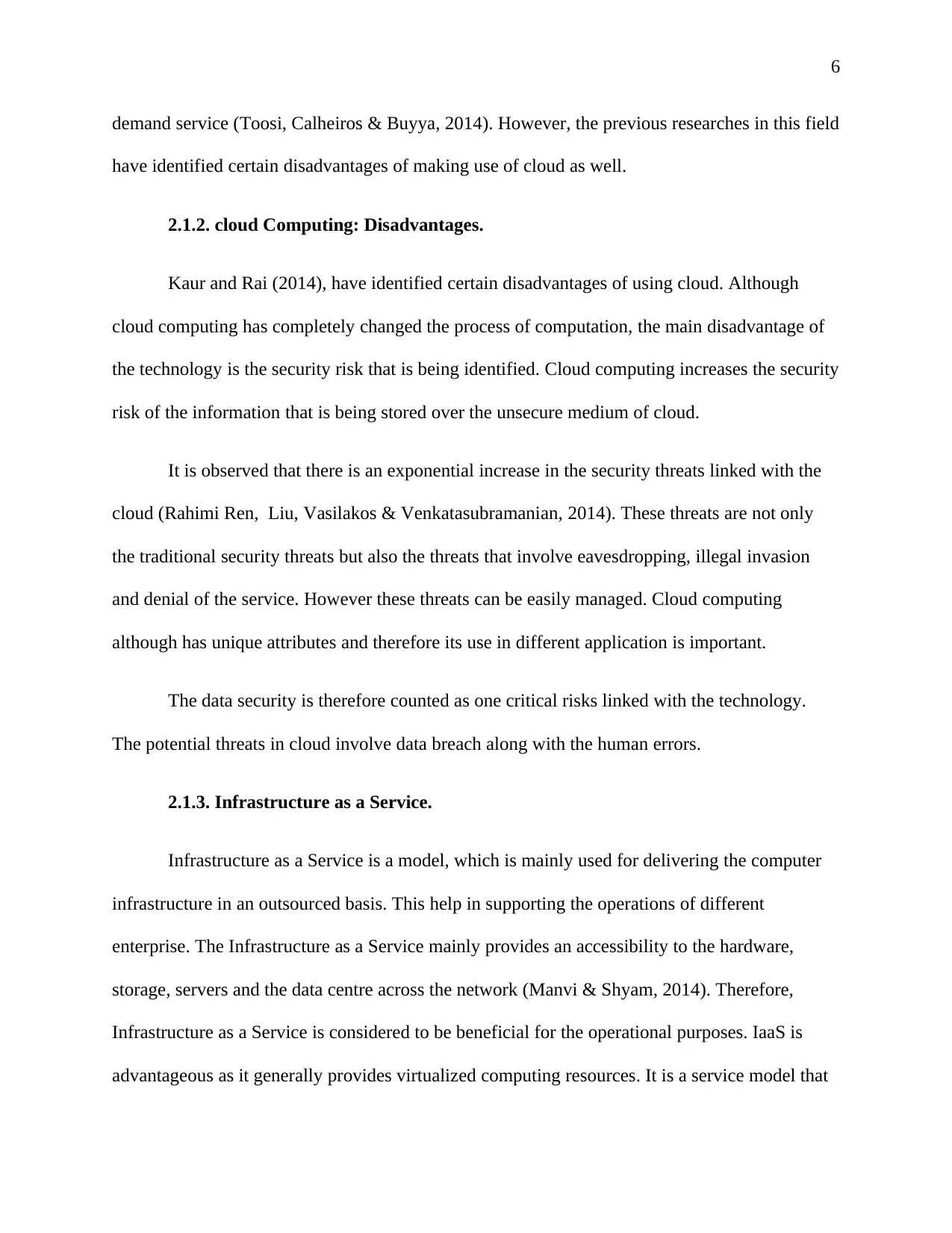
6
demand service (Toosi, Calheiros & Buyya, 2014). However, the previous researches in this field
have identified certain disadvantages of making use of cloud as well.
2.1.2. cloud Computing: Disadvantages.
Kaur and Rai (2014), have identified certain disadvantages of using cloud. Although
cloud computing has completely changed the process of computation, the main disadvantage of
the technology is the security risk that is being identified. Cloud computing increases the security
risk of the information that is being stored over the unsecure medium of cloud.
It is observed that there is an exponential increase in the security threats linked with the
cloud (Rahimi Ren, Liu, Vasilakos & Venkatasubramanian, 2014). These threats are not only
the traditional security threats but also the threats that involve eavesdropping, illegal invasion
and denial of the service. However these threats can be easily managed. Cloud computing
although has unique attributes and therefore its use in different application is important.
The data security is therefore counted as one critical risks linked with the technology.
The potential threats in cloud involve data breach along with the human errors.
2.1.3. Infrastructure as a Service.
Infrastructure as a Service is a model, which is mainly used for delivering the computer
infrastructure in an outsourced basis. This help in supporting the operations of different
enterprise. The Infrastructure as a Service mainly provides an accessibility to the hardware,
storage, servers and the data centre across the network (Manvi & Shyam, 2014). Therefore,
Infrastructure as a Service is considered to be beneficial for the operational purposes. IaaS is
advantageous as it generally provides virtualized computing resources. It is a service model that
demand service (Toosi, Calheiros & Buyya, 2014). However, the previous researches in this field
have identified certain disadvantages of making use of cloud as well.
2.1.2. cloud Computing: Disadvantages.
Kaur and Rai (2014), have identified certain disadvantages of using cloud. Although
cloud computing has completely changed the process of computation, the main disadvantage of
the technology is the security risk that is being identified. Cloud computing increases the security
risk of the information that is being stored over the unsecure medium of cloud.
It is observed that there is an exponential increase in the security threats linked with the
cloud (Rahimi Ren, Liu, Vasilakos & Venkatasubramanian, 2014). These threats are not only
the traditional security threats but also the threats that involve eavesdropping, illegal invasion
and denial of the service. However these threats can be easily managed. Cloud computing
although has unique attributes and therefore its use in different application is important.
The data security is therefore counted as one critical risks linked with the technology.
The potential threats in cloud involve data breach along with the human errors.
2.1.3. Infrastructure as a Service.
Infrastructure as a Service is a model, which is mainly used for delivering the computer
infrastructure in an outsourced basis. This help in supporting the operations of different
enterprise. The Infrastructure as a Service mainly provides an accessibility to the hardware,
storage, servers and the data centre across the network (Manvi & Shyam, 2014). Therefore,
Infrastructure as a Service is considered to be beneficial for the operational purposes. IaaS is
advantageous as it generally provides virtualized computing resources. It is a service model that
Paraphrase This Document
Need a fresh take? Get an instant paraphrase of this document with our AI Paraphraser
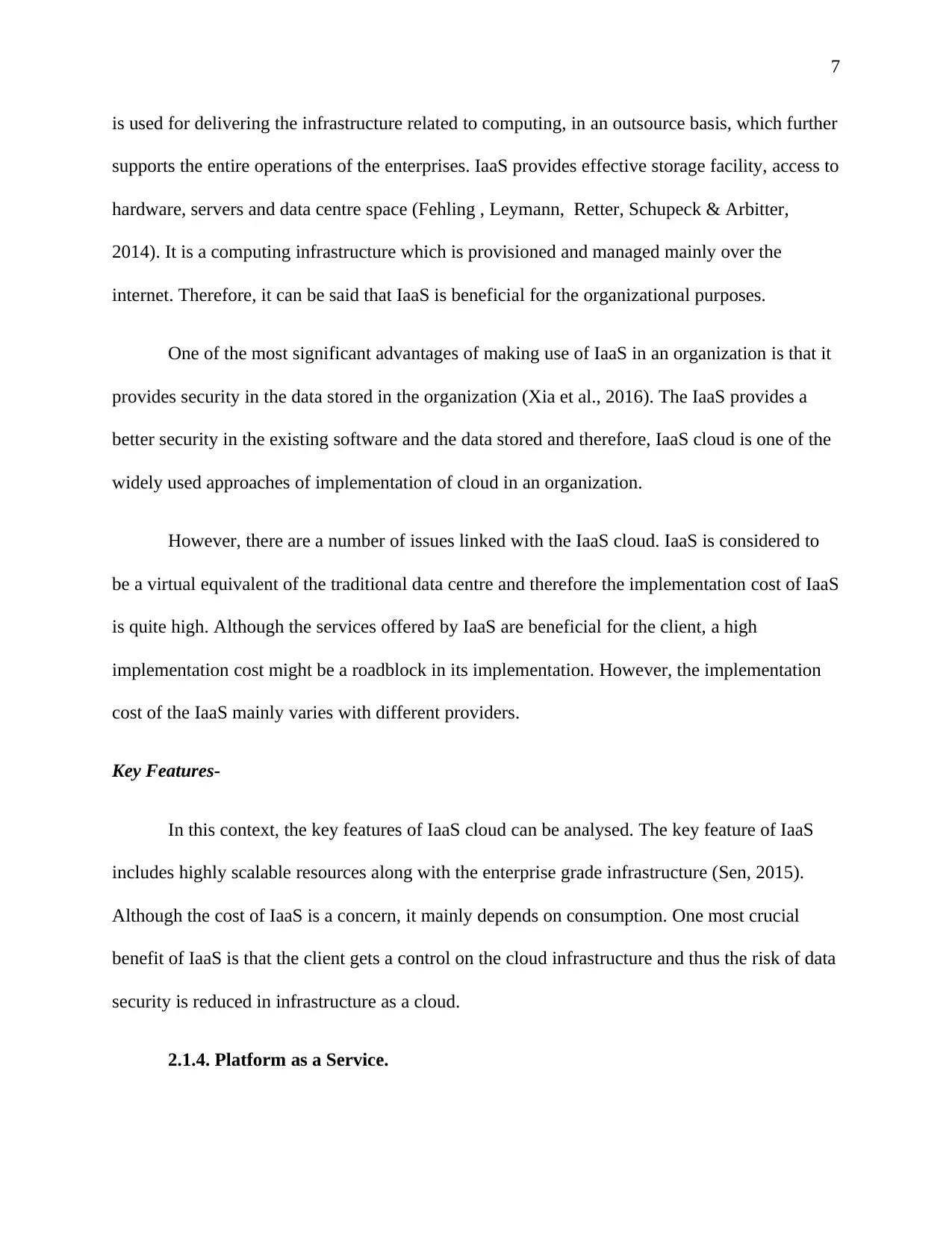
7
is used for delivering the infrastructure related to computing, in an outsource basis, which further
supports the entire operations of the enterprises. IaaS provides effective storage facility, access to
hardware, servers and data centre space (Fehling , Leymann, Retter, Schupeck & Arbitter,
2014). It is a computing infrastructure which is provisioned and managed mainly over the
internet. Therefore, it can be said that IaaS is beneficial for the organizational purposes.
One of the most significant advantages of making use of IaaS in an organization is that it
provides security in the data stored in the organization (Xia et al., 2016). The IaaS provides a
better security in the existing software and the data stored and therefore, IaaS cloud is one of the
widely used approaches of implementation of cloud in an organization.
However, there are a number of issues linked with the IaaS cloud. IaaS is considered to
be a virtual equivalent of the traditional data centre and therefore the implementation cost of IaaS
is quite high. Although the services offered by IaaS are beneficial for the client, a high
implementation cost might be a roadblock in its implementation. However, the implementation
cost of the IaaS mainly varies with different providers.
Key Features-
In this context, the key features of IaaS cloud can be analysed. The key feature of IaaS
includes highly scalable resources along with the enterprise grade infrastructure (Sen, 2015).
Although the cost of IaaS is a concern, it mainly depends on consumption. One most crucial
benefit of IaaS is that the client gets a control on the cloud infrastructure and thus the risk of data
security is reduced in infrastructure as a cloud.
2.1.4. Platform as a Service.
is used for delivering the infrastructure related to computing, in an outsource basis, which further
supports the entire operations of the enterprises. IaaS provides effective storage facility, access to
hardware, servers and data centre space (Fehling , Leymann, Retter, Schupeck & Arbitter,
2014). It is a computing infrastructure which is provisioned and managed mainly over the
internet. Therefore, it can be said that IaaS is beneficial for the organizational purposes.
One of the most significant advantages of making use of IaaS in an organization is that it
provides security in the data stored in the organization (Xia et al., 2016). The IaaS provides a
better security in the existing software and the data stored and therefore, IaaS cloud is one of the
widely used approaches of implementation of cloud in an organization.
However, there are a number of issues linked with the IaaS cloud. IaaS is considered to
be a virtual equivalent of the traditional data centre and therefore the implementation cost of IaaS
is quite high. Although the services offered by IaaS are beneficial for the client, a high
implementation cost might be a roadblock in its implementation. However, the implementation
cost of the IaaS mainly varies with different providers.
Key Features-
In this context, the key features of IaaS cloud can be analysed. The key feature of IaaS
includes highly scalable resources along with the enterprise grade infrastructure (Sen, 2015).
Although the cost of IaaS is a concern, it mainly depends on consumption. One most crucial
benefit of IaaS is that the client gets a control on the cloud infrastructure and thus the risk of data
security is reduced in infrastructure as a cloud.
2.1.4. Platform as a Service.
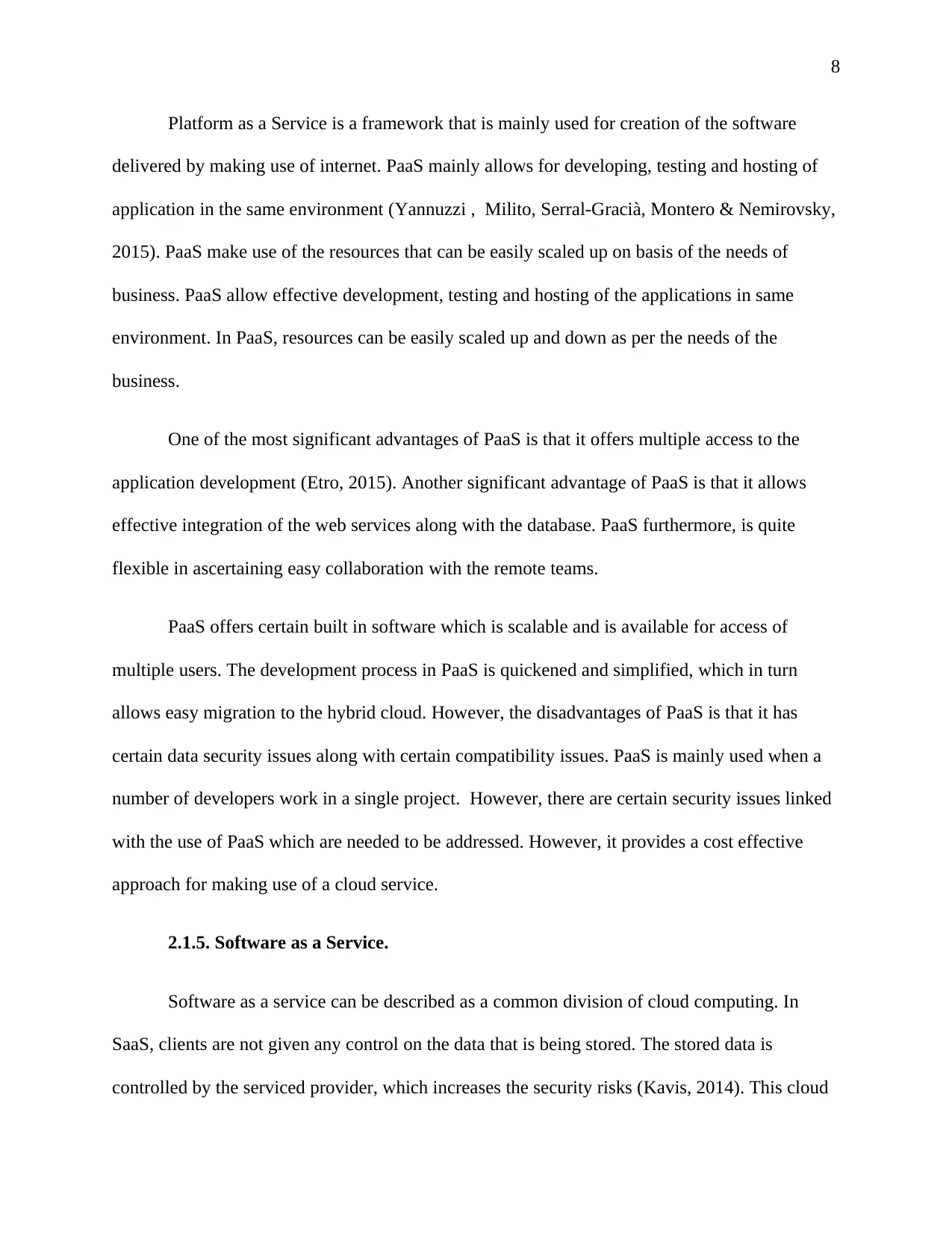
8
Platform as a Service is a framework that is mainly used for creation of the software
delivered by making use of internet. PaaS mainly allows for developing, testing and hosting of
application in the same environment (Yannuzzi , Milito, Serral-Gracià, Montero & Nemirovsky,
2015). PaaS make use of the resources that can be easily scaled up on basis of the needs of
business. PaaS allow effective development, testing and hosting of the applications in same
environment. In PaaS, resources can be easily scaled up and down as per the needs of the
business.
One of the most significant advantages of PaaS is that it offers multiple access to the
application development (Etro, 2015). Another significant advantage of PaaS is that it allows
effective integration of the web services along with the database. PaaS furthermore, is quite
flexible in ascertaining easy collaboration with the remote teams.
PaaS offers certain built in software which is scalable and is available for access of
multiple users. The development process in PaaS is quickened and simplified, which in turn
allows easy migration to the hybrid cloud. However, the disadvantages of PaaS is that it has
certain data security issues along with certain compatibility issues. PaaS is mainly used when a
number of developers work in a single project. However, there are certain security issues linked
with the use of PaaS which are needed to be addressed. However, it provides a cost effective
approach for making use of a cloud service.
2.1.5. Software as a Service.
Software as a service can be described as a common division of cloud computing. In
SaaS, clients are not given any control on the data that is being stored. The stored data is
controlled by the serviced provider, which increases the security risks (Kavis, 2014). This cloud
Platform as a Service is a framework that is mainly used for creation of the software
delivered by making use of internet. PaaS mainly allows for developing, testing and hosting of
application in the same environment (Yannuzzi , Milito, Serral-Gracià, Montero & Nemirovsky,
2015). PaaS make use of the resources that can be easily scaled up on basis of the needs of
business. PaaS allow effective development, testing and hosting of the applications in same
environment. In PaaS, resources can be easily scaled up and down as per the needs of the
business.
One of the most significant advantages of PaaS is that it offers multiple access to the
application development (Etro, 2015). Another significant advantage of PaaS is that it allows
effective integration of the web services along with the database. PaaS furthermore, is quite
flexible in ascertaining easy collaboration with the remote teams.
PaaS offers certain built in software which is scalable and is available for access of
multiple users. The development process in PaaS is quickened and simplified, which in turn
allows easy migration to the hybrid cloud. However, the disadvantages of PaaS is that it has
certain data security issues along with certain compatibility issues. PaaS is mainly used when a
number of developers work in a single project. However, there are certain security issues linked
with the use of PaaS which are needed to be addressed. However, it provides a cost effective
approach for making use of a cloud service.
2.1.5. Software as a Service.
Software as a service can be described as a common division of cloud computing. In
SaaS, clients are not given any control on the data that is being stored. The stored data is
controlled by the serviced provider, which increases the security risks (Kavis, 2014). This cloud
⊘ This is a preview!⊘
Do you want full access?
Subscribe today to unlock all pages.

Trusted by 1+ million students worldwide
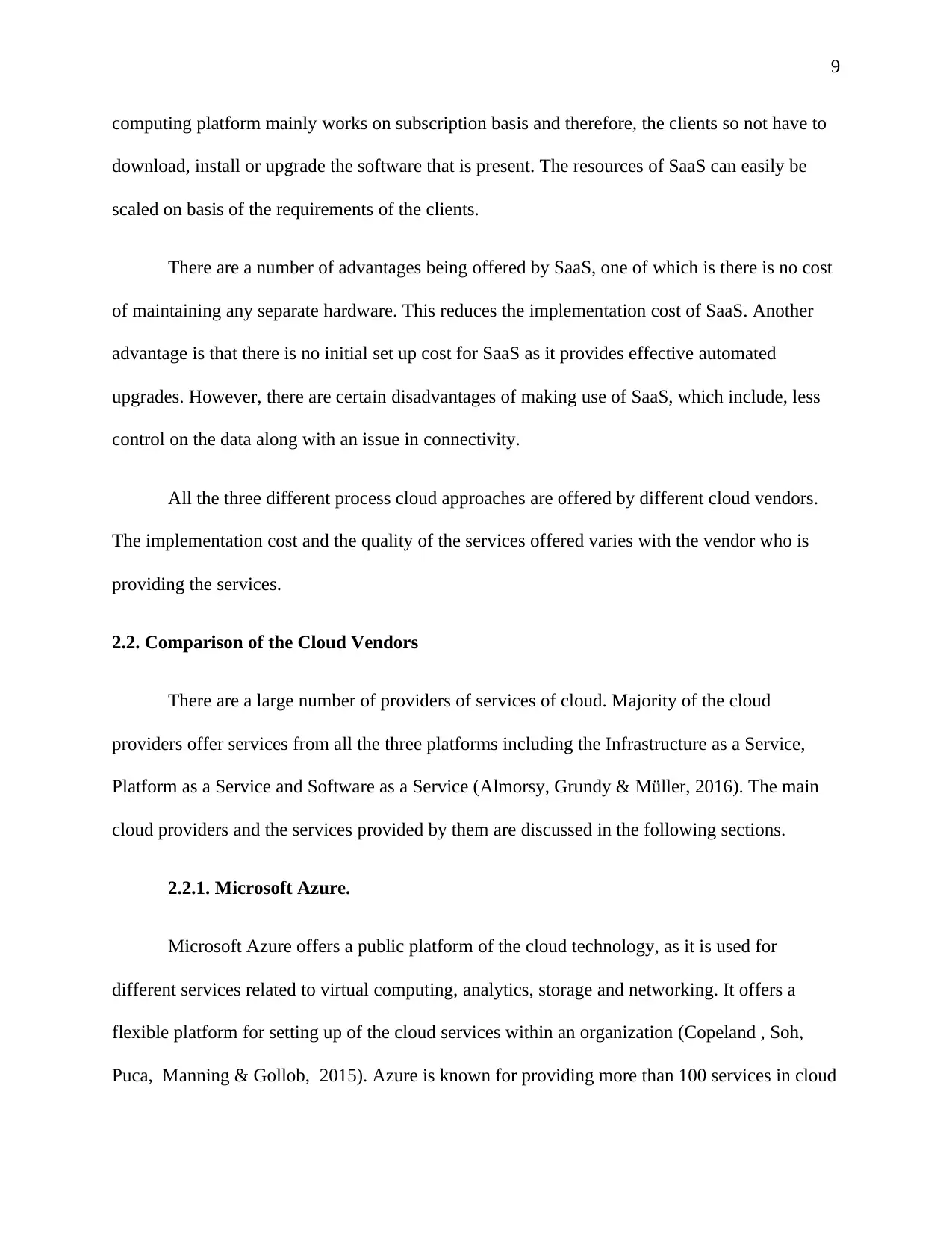
9
computing platform mainly works on subscription basis and therefore, the clients so not have to
download, install or upgrade the software that is present. The resources of SaaS can easily be
scaled on basis of the requirements of the clients.
There are a number of advantages being offered by SaaS, one of which is there is no cost
of maintaining any separate hardware. This reduces the implementation cost of SaaS. Another
advantage is that there is no initial set up cost for SaaS as it provides effective automated
upgrades. However, there are certain disadvantages of making use of SaaS, which include, less
control on the data along with an issue in connectivity.
All the three different process cloud approaches are offered by different cloud vendors.
The implementation cost and the quality of the services offered varies with the vendor who is
providing the services.
2.2. Comparison of the Cloud Vendors
There are a large number of providers of services of cloud. Majority of the cloud
providers offer services from all the three platforms including the Infrastructure as a Service,
Platform as a Service and Software as a Service (Almorsy, Grundy & Müller, 2016). The main
cloud providers and the services provided by them are discussed in the following sections.
2.2.1. Microsoft Azure.
Microsoft Azure offers a public platform of the cloud technology, as it is used for
different services related to virtual computing, analytics, storage and networking. It offers a
flexible platform for setting up of the cloud services within an organization (Copeland , Soh,
Puca, Manning & Gollob, 2015). Azure is known for providing more than 100 services in cloud
computing platform mainly works on subscription basis and therefore, the clients so not have to
download, install or upgrade the software that is present. The resources of SaaS can easily be
scaled on basis of the requirements of the clients.
There are a number of advantages being offered by SaaS, one of which is there is no cost
of maintaining any separate hardware. This reduces the implementation cost of SaaS. Another
advantage is that there is no initial set up cost for SaaS as it provides effective automated
upgrades. However, there are certain disadvantages of making use of SaaS, which include, less
control on the data along with an issue in connectivity.
All the three different process cloud approaches are offered by different cloud vendors.
The implementation cost and the quality of the services offered varies with the vendor who is
providing the services.
2.2. Comparison of the Cloud Vendors
There are a large number of providers of services of cloud. Majority of the cloud
providers offer services from all the three platforms including the Infrastructure as a Service,
Platform as a Service and Software as a Service (Almorsy, Grundy & Müller, 2016). The main
cloud providers and the services provided by them are discussed in the following sections.
2.2.1. Microsoft Azure.
Microsoft Azure offers a public platform of the cloud technology, as it is used for
different services related to virtual computing, analytics, storage and networking. It offers a
flexible platform for setting up of the cloud services within an organization (Copeland , Soh,
Puca, Manning & Gollob, 2015). Azure is known for providing more than 100 services in cloud
Paraphrase This Document
Need a fresh take? Get an instant paraphrase of this document with our AI Paraphraser
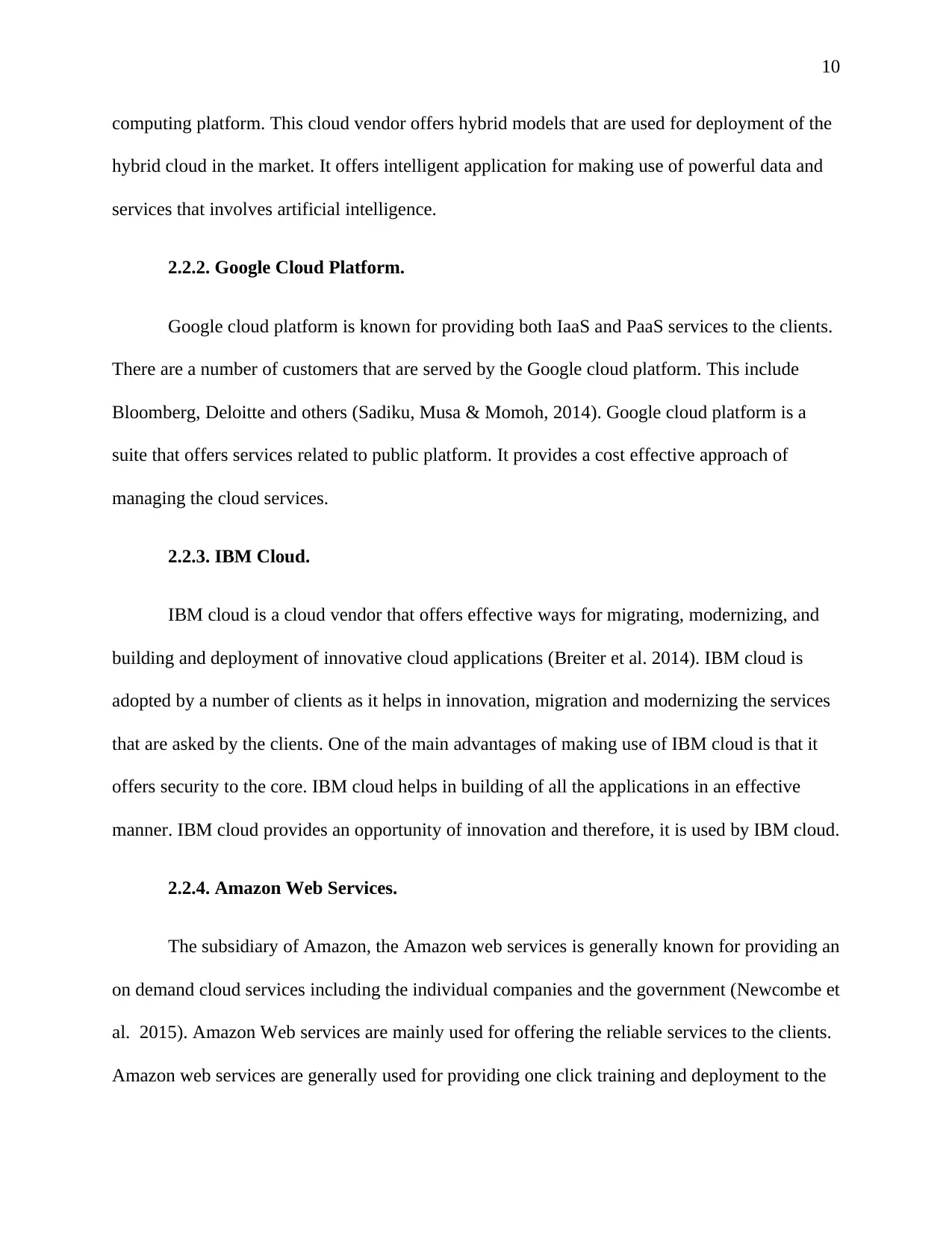
10
computing platform. This cloud vendor offers hybrid models that are used for deployment of the
hybrid cloud in the market. It offers intelligent application for making use of powerful data and
services that involves artificial intelligence.
2.2.2. Google Cloud Platform.
Google cloud platform is known for providing both IaaS and PaaS services to the clients.
There are a number of customers that are served by the Google cloud platform. This include
Bloomberg, Deloitte and others (Sadiku, Musa & Momoh, 2014). Google cloud platform is a
suite that offers services related to public platform. It provides a cost effective approach of
managing the cloud services.
2.2.3. IBM Cloud.
IBM cloud is a cloud vendor that offers effective ways for migrating, modernizing, and
building and deployment of innovative cloud applications (Breiter et al. 2014). IBM cloud is
adopted by a number of clients as it helps in innovation, migration and modernizing the services
that are asked by the clients. One of the main advantages of making use of IBM cloud is that it
offers security to the core. IBM cloud helps in building of all the applications in an effective
manner. IBM cloud provides an opportunity of innovation and therefore, it is used by IBM cloud.
2.2.4. Amazon Web Services.
The subsidiary of Amazon, the Amazon web services is generally known for providing an
on demand cloud services including the individual companies and the government (Newcombe et
al. 2015). Amazon Web services are mainly used for offering the reliable services to the clients.
Amazon web services are generally used for providing one click training and deployment to the
computing platform. This cloud vendor offers hybrid models that are used for deployment of the
hybrid cloud in the market. It offers intelligent application for making use of powerful data and
services that involves artificial intelligence.
2.2.2. Google Cloud Platform.
Google cloud platform is known for providing both IaaS and PaaS services to the clients.
There are a number of customers that are served by the Google cloud platform. This include
Bloomberg, Deloitte and others (Sadiku, Musa & Momoh, 2014). Google cloud platform is a
suite that offers services related to public platform. It provides a cost effective approach of
managing the cloud services.
2.2.3. IBM Cloud.
IBM cloud is a cloud vendor that offers effective ways for migrating, modernizing, and
building and deployment of innovative cloud applications (Breiter et al. 2014). IBM cloud is
adopted by a number of clients as it helps in innovation, migration and modernizing the services
that are asked by the clients. One of the main advantages of making use of IBM cloud is that it
offers security to the core. IBM cloud helps in building of all the applications in an effective
manner. IBM cloud provides an opportunity of innovation and therefore, it is used by IBM cloud.
2.2.4. Amazon Web Services.
The subsidiary of Amazon, the Amazon web services is generally known for providing an
on demand cloud services including the individual companies and the government (Newcombe et
al. 2015). Amazon Web services are mainly used for offering the reliable services to the clients.
Amazon web services are generally used for providing one click training and deployment to the
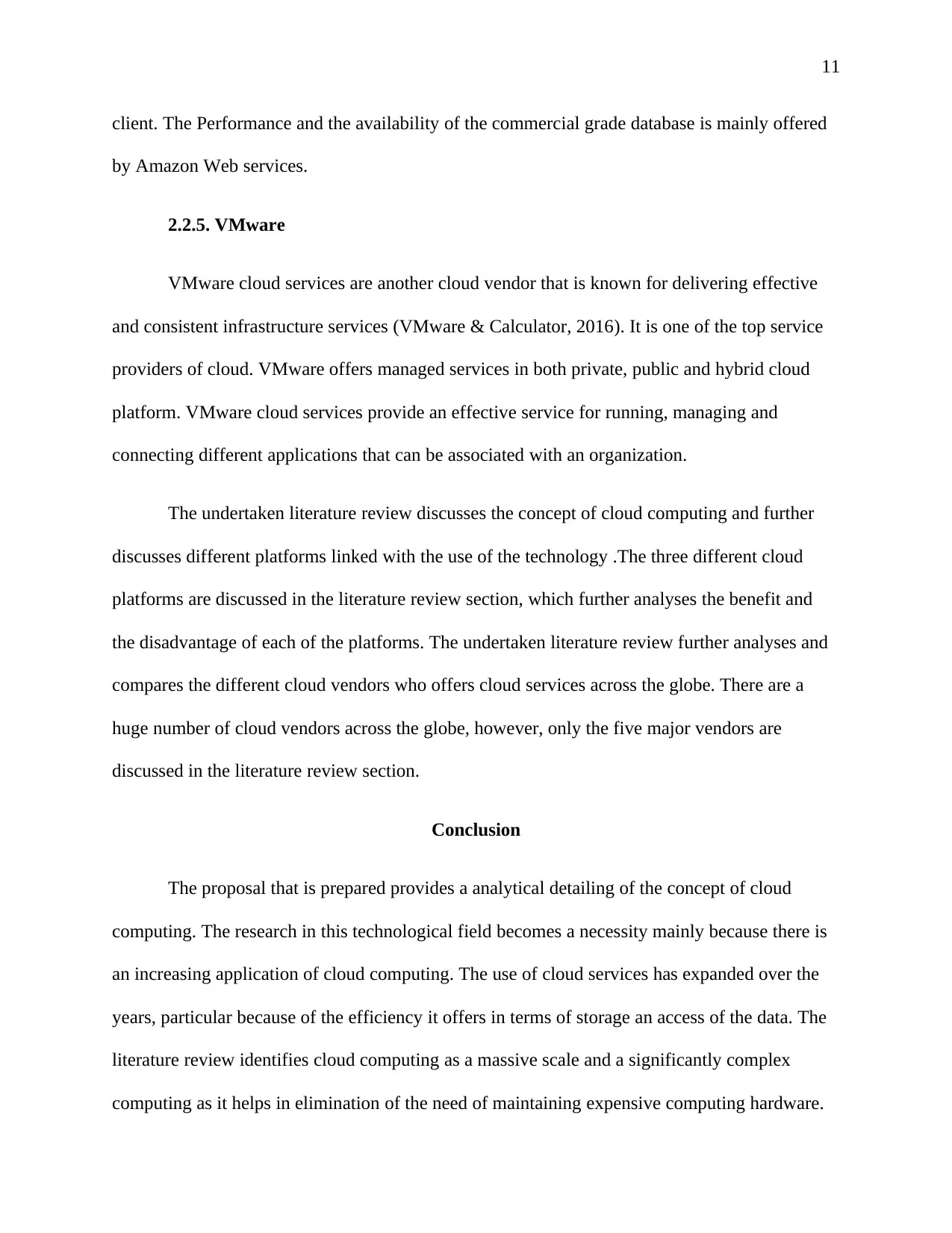
11
client. The Performance and the availability of the commercial grade database is mainly offered
by Amazon Web services.
2.2.5. VMware
VMware cloud services are another cloud vendor that is known for delivering effective
and consistent infrastructure services (VMware & Calculator, 2016). It is one of the top service
providers of cloud. VMware offers managed services in both private, public and hybrid cloud
platform. VMware cloud services provide an effective service for running, managing and
connecting different applications that can be associated with an organization.
The undertaken literature review discusses the concept of cloud computing and further
discusses different platforms linked with the use of the technology .The three different cloud
platforms are discussed in the literature review section, which further analyses the benefit and
the disadvantage of each of the platforms. The undertaken literature review further analyses and
compares the different cloud vendors who offers cloud services across the globe. There are a
huge number of cloud vendors across the globe, however, only the five major vendors are
discussed in the literature review section.
Conclusion
The proposal that is prepared provides a analytical detailing of the concept of cloud
computing. The research in this technological field becomes a necessity mainly because there is
an increasing application of cloud computing. The use of cloud services has expanded over the
years, particular because of the efficiency it offers in terms of storage an access of the data. The
literature review identifies cloud computing as a massive scale and a significantly complex
computing as it helps in elimination of the need of maintaining expensive computing hardware.
client. The Performance and the availability of the commercial grade database is mainly offered
by Amazon Web services.
2.2.5. VMware
VMware cloud services are another cloud vendor that is known for delivering effective
and consistent infrastructure services (VMware & Calculator, 2016). It is one of the top service
providers of cloud. VMware offers managed services in both private, public and hybrid cloud
platform. VMware cloud services provide an effective service for running, managing and
connecting different applications that can be associated with an organization.
The undertaken literature review discusses the concept of cloud computing and further
discusses different platforms linked with the use of the technology .The three different cloud
platforms are discussed in the literature review section, which further analyses the benefit and
the disadvantage of each of the platforms. The undertaken literature review further analyses and
compares the different cloud vendors who offers cloud services across the globe. There are a
huge number of cloud vendors across the globe, however, only the five major vendors are
discussed in the literature review section.
Conclusion
The proposal that is prepared provides a analytical detailing of the concept of cloud
computing. The research in this technological field becomes a necessity mainly because there is
an increasing application of cloud computing. The use of cloud services has expanded over the
years, particular because of the efficiency it offers in terms of storage an access of the data. The
literature review identifies cloud computing as a massive scale and a significantly complex
computing as it helps in elimination of the need of maintaining expensive computing hardware.
⊘ This is a preview!⊘
Do you want full access?
Subscribe today to unlock all pages.

Trusted by 1+ million students worldwide
1 out of 19
Related Documents
Your All-in-One AI-Powered Toolkit for Academic Success.
+13062052269
info@desklib.com
Available 24*7 on WhatsApp / Email
![[object Object]](/_next/static/media/star-bottom.7253800d.svg)
Unlock your academic potential
Copyright © 2020–2025 A2Z Services. All Rights Reserved. Developed and managed by ZUCOL.





